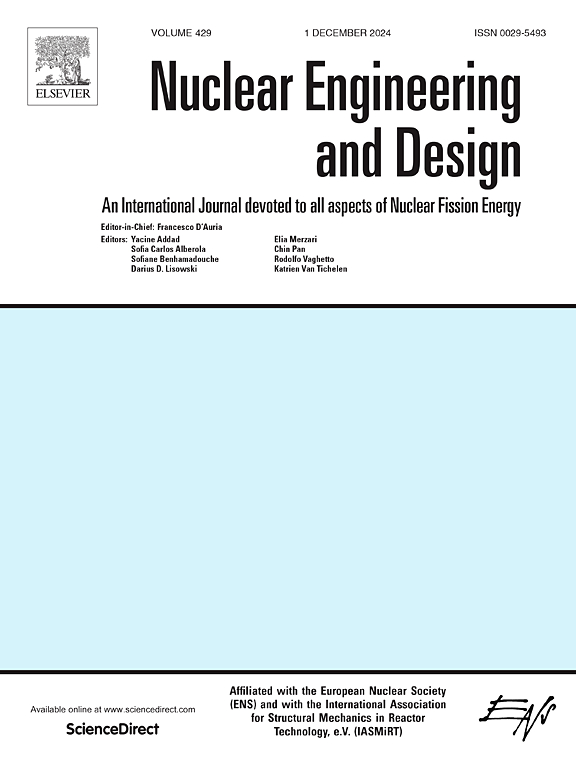Optimizing the small modular reactor core loading with dual-cooled fuel via Henry gas solubility optimization algorithm
IF 1.9
3区 工程技术
Q1 NUCLEAR SCIENCE & TECHNOLOGY
引用次数: 0
Abstract
An investigation into the influence of innovative dual-cooled fuel geometric structural characteristics on critical reactor core parameters, such as temperature reactivity coefficients and convective heat transfer coefficient, is essential for accurately assessing its neutronic and thermohydraulic performance and estimating safety margins. This study calculated the fuel and coolant/moderator temperature reactivity coefficients in the NuScale-type reactor using WIMS-CITATION codes. Additionally, the impact of increasing the size of dual-cooled fuel rods on these coefficients was analyzed. The study also calculated the hot rod convective heat transfer coefficient for proposed fuel rods using a Computational Fluid Dynamics (CFD) and sub-channel model method. The results demonstrated that increasing the internal radius of the fuel decreases the temperature reactivity feedback coefficient of fuels, while the feedback coefficient of coolant exhibits a parabolic trend. All proposed fuel rods exhibited negative coolant and fuel temperature reactivity coefficients, and increasing the internal radius resulted in a reduction in the convective heat transfer coefficient. Furthermore, the study explored the use of Artificial Neural Network (ANN) and Gene Expression Programming (GEP) models to develop an optimal method with low computational cost. Based on statistical indicators, the ANN was found to outperform GEP. Finally, the designed ANN, coupled with the Henry Gas Solubility Optimization (HGSO) algorithm, was employed to determine the optimal dual-cooled fuel based on desired parameters.
求助全文
约1分钟内获得全文
求助全文
来源期刊

Nuclear Engineering and Design
工程技术-核科学技术
CiteScore
3.40
自引率
11.80%
发文量
377
审稿时长
5 months
期刊介绍:
Nuclear Engineering and Design covers the wide range of disciplines involved in the engineering, design, safety and construction of nuclear fission reactors. The Editors welcome papers both on applied and innovative aspects and developments in nuclear science and technology.
Fundamentals of Reactor Design include:
• Thermal-Hydraulics and Core Physics
• Safety Analysis, Risk Assessment (PSA)
• Structural and Mechanical Engineering
• Materials Science
• Fuel Behavior and Design
• Structural Plant Design
• Engineering of Reactor Components
• Experiments
Aspects beyond fundamentals of Reactor Design covered:
• Accident Mitigation Measures
• Reactor Control Systems
• Licensing Issues
• Safeguard Engineering
• Economy of Plants
• Reprocessing / Waste Disposal
• Applications of Nuclear Energy
• Maintenance
• Decommissioning
Papers on new reactor ideas and developments (Generation IV reactors) such as inherently safe modular HTRs, High Performance LWRs/HWRs and LMFBs/GFR will be considered; Actinide Burners, Accelerator Driven Systems, Energy Amplifiers and other special designs of power and research reactors and their applications are also encouraged.
 求助内容:
求助内容: 应助结果提醒方式:
应助结果提醒方式:


